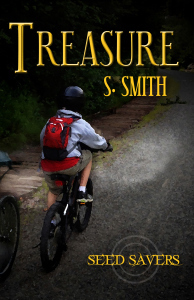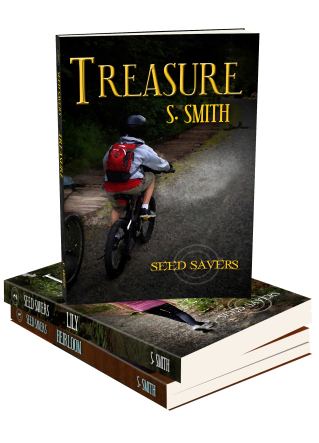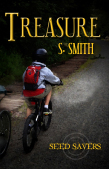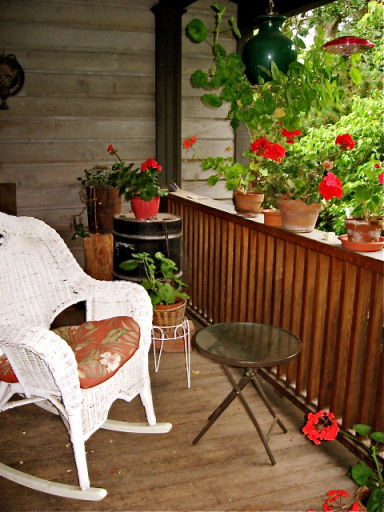S. Smith's Blog, page 16
September 14, 2016
The Post Heirloom Expo Post
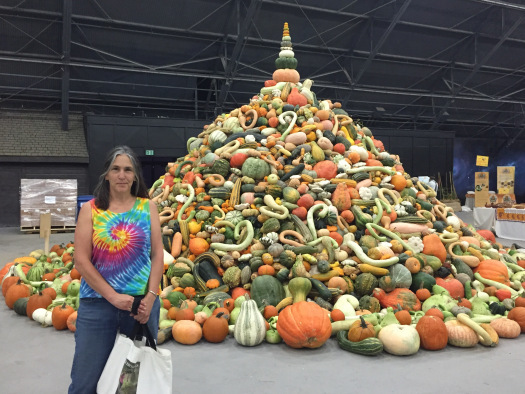
Whew! Time to catch up. Already a week has passed since I arrived in Santa Rosa for my third Heirloom Expo. They switched up a lot of things, and I personally had a bad location for my booth, but all in all it was a great time.
I attended these presentations: “MONOCULTURE-Past and Current Issues, and Genetic Diversity” by Hebron Smith; a part of “The Wild Wisdom of Weeds and the Integrity of Wild Seeds” by Katrina Blair; a part of “Seed Matters Aotearoa & Oceania–Our Farms, Our Food, Our Future!” by Fran Murrell and Claire Bleakey; a part of a panel on Seed Companies and the Seed Industry in America, a part of a panel featuring 3 teen activists in the Food Movement; “SynBio, GMOs 2.O: The Next Generation of Genetic Engineering,” and a panel including Vani Hari (Food Babe) and Gary Ruskin about how food and agrichemical companies promote industry propaganda.
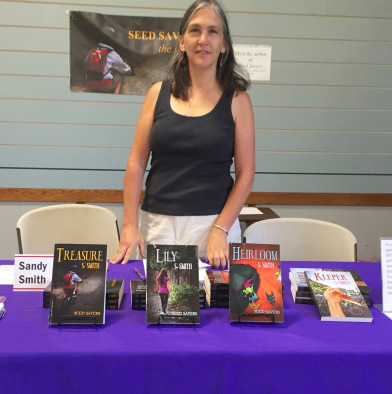
There are always many presentations to choose from, but I spend most of my time behind my table telling people about my books. :) I was very fortunate this year to have both my husband Cy, and my friend Janine, help staff the table, and Janine’s husband, Barry, helping with meals.

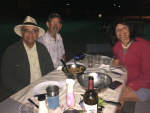
I learned new things, was impressed (as always) by the beauty of vegetables, and enjoyed meeting old friends and making new ones.
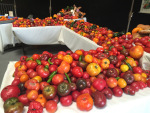
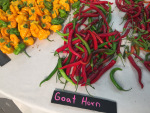
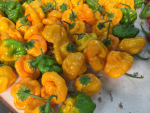

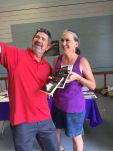
I hope to expand more in future posts about what I learned, although I’m the first to admit I don’t always get there 0:
Three things right now:
1. After arriving home I found out that the location of the Heirloom Expo is threatened. For some reason the health department in Sonoma County came in and fined dozens of folks for giving away produce and other practices that have been happening for six years. Read more here.
2. As of this morning, Bayer has merged with Monsanto giving this newly formed mega company an even larger control over agricultural products.
3. Although there was an advance screening of the movie, Seed: The Untold Story in town while I was down there, I didn’t get to see it. It is in theatres now, so if you hadn’t heard of it, consider this your FYI and read more about it or watch the trailer here.
And hopefully some day I can announce Seed Savers: Treasure — The Movie
September 1, 2016
Top 15 Reasons to Attend Heirloom Expo
Okay, so this was supposed to be a “TOP 10” list, but there were just so many good reasons…:)
Top 15 Reasons to Attend the National Heirloom Expo in Santa Rosa, California
Kid friendly
Giant Pumpkins

Educational workshops
Tables of beautiful veggies
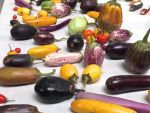
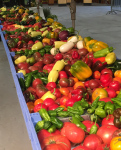
Meet old friends
Make new friends
Pigs
Healthy food
Cool products from awesome vendors

That’s me!
Rooster crowing competition
Interesting Exhibits

Musical entertainment
Awe-inspiring speakers

Meet your heroes


Contribute to a healthier planet with healthier inhabitants
So what are you waiting for? Make your plans to come to the National Heirloom Expo September 6, 7, 8 for 2016. And don’t forget to come by my table and say hi.
August 31, 2016
Treasure on #instaFreebie Through Labor Day
I’ve been busy enjoying the summer months and neglecting my blog. Deep sigh. But on the other hand, I have posted lots and lots of photos to Instagram!
I hope to make amends soon and maybe catch y’all up on what I’ve been doing, but for now I wanted to let everyone know that Treasure is again free, but only for a limited time and only on instaFreebie. After spending quite a while as a “first in series free” book, I changed the price to $2.99 a while back. Which it still is without the instaFreebie code. So if you are new to the Seed Savers series start here, then download here.
And hopefully check back in from time to time or say “hi” in the comment section below.
InstaFreebie Code for Treasure
S. Smith is the author of the awesome and award-winning middle grade/YA series, Seed Savers. Visit her Facebook and Pinterest pages. Follow her on Twitter.
July 1, 2016
Authors, Talk About Your Book on Speak Up Talk Radio
Recently I had the opportunity to talk about my book series, Seed Savers, to Pat Rullo at Speak Up Talk Radio. I don’t understand the entire radio network thing, but they have an entire section on guest interviews, and most to the recent interviewees have been authors.
The interview was easy to set up and cost $52 to be listed on their site for an entire year. You can pay $25 more to have your interview additionally listed on iTunes and Stitcher. Not only that, but the money is donated to a cause called the Sewport Project.
Pat was friendly to talk to and the interview sped by. Since it doesn’t air live, she can cut out any rough spots. I haven’t listened to my interview. I felt like I prattled on a bit, so I hope it ended up okay…but I’m just not ready to hear it yet. :0
Since there isn’t a lot out there yet about SUTR, I don’t know whether or not the podcast will help sell books, but if nothing else it’s good practice.
Find out everything you need to know here or send Pat an email as listed on the link. She is very good about responding quickly.
Here is the link to my interview, in case you were wondering :): My Interview on Speak Up Talk Radio
Happy authoring!
S. Smith is the author of the awesome and award-winning middle grade/YA series, Seed Savers. Visit her Facebook and Pinterest pages. Follow her on Twitter . Sign up for the newsletter!

June 14, 2016
Box Set Sale: Seed Savers Series
I’m a day late, but the sale goes for two more days. Yesterday was my birthday so I marked down my Seed Savers three book boxed set from $5.99 to $1.99. *WOW* That’s the first three books in the series for just under two bucks.
The sale goes only until June 16 (my brother’s birthday :)). After that, it will be $5.99 again, which, by the way, is still a great deal. Someday the books will be famous and it will be much harder to get them at a low price. Okay, so that’s maybe just a birthday wish, but here’s hopin’.
Need more information about the series? Go here. The individual Amazon pages for each book also have a lot of good reviews, so you can check those out if you want. Start here.
And yes, I had a great birthday.[image error]
S. Smith is the author of the awesome and award-winning middle grade/YA series, Seed Savers. Visit her Facebook and Pinterest pages. Follow her on Twitter . Sign up for the newsletter!

June 9, 2016
Who Owns the Seeds?

Whenever a story like the one above hits the news I always hear from fans of my books. They see the parallels of a Bayer-Monsanto merger with the Seed Savers future in which Nipungyo, and ultimately GRIM, take over the food system.
In the NPR story, the Monsanto chair is quoted as saying,”We believe in the substantial benefits an integrated strategy could provide to growers and broader society, and we have long respected Bayer’s business.” A merger of the two giants would create the world’s largest supplier of seeds and agricultural chemicals.
Right now, 75% (source) of the seeds planted are owned by just 10 companies (Monsanto and Bayer among them.) Nearly 50% of those seeds are owned by just three companies. So, yes, pay attention when you hear the stories.
And don’t forget to save your own seeds! You may be glad you did.[image error]
Excerpt from Treasure (Seed Savers, 1) Chapter 10:
It had been years since Ana was cited for home gardening. Thankfully, neither her seeds nor her books had been found, but all the herbs and vegetables were confiscated or ripped from the ground. She had claimed she thought the cilantro, turnips, and chard sprouting throughout her small yard were inedible weeds that had gained a foothold in her landscaping. Indeed, they looked the part.
Up until the raid, Ana had grown illegal plants for years without a problem. Since then, she’d been more careful. She grew most plants indoors now, and sometimes scattered a few seeds in empty lots around town, collecting the seeds later in the season. She wanted to keep as many fresh seeds as possible. It was all part of being a Seed Saver.
And now she was doing the last thing Seed Savers did: teaching someone younger to carry it forward until the dawn of a new day, a day when the old ways of gardening were no longer unlawful. She sighed deeply, thinking of the task in front of her, and of the looming shadow on the land: GRIM.
Although it was GRIM now—an actual arm of the government—it had started earlier with private corporations: BENAR, Nipungyo, Qubceq. Some pointed to the Supreme Court ruling of 1980 okaying the patenting of living organisms as the beginning of the end.
A prediction was made around the turn of the century that if Nipungyo had its way, no farmer in the country, perhaps even the world, would ever own a seed again. It was a prediction that had since gained federal authorization in several nations, and it applied to everyone, not just farmers. All sanctioned seeds in America were genetically enhanced and patented. Owning, purchasing, and planting of all seeds was controlled by the government. The average person knew nothing about growing his or her own food. Ana shook her head. The average person wouldn’t recognize food beyond Vitees, Sweeties, Carbos, Proteins, and Snacks.
She thought back to how it all began. The loss of freedom in gardening and farming was gradual, and started—or so it appeared—innocently enough. Scientists created biotec, or genetically modified seeds, to improve crop production: seeds whose plants were resistant to drought, disease, and insect damage; seeds that produced plants with larger fruit and longer shelf life. Chemical companies created seeds whose plants survived their herbicides, making it easier for farmers to produce a clean and weed-free crop.
The innovations seemed to benefit everybody: the farmer, third world countries, consumers. Like vaccinations or pasteurized milk contributing to the good of humanity, biotec plants were heralded as an improved way of food business. One difference, however, was the ownership rights. A few large corporations, and one in particular—Nipungyo—soon had a corner on the market of genetically modified seeds.
A tear rolled down Ana’s face as she recalled the way it had played out. The first to go were small farmers who didn’t buy into GM seeds; they had no interest in Nipungyo’s herbicides or high-priced seeds. They continued to farm as they always had, by saving seeds from each year’s crop to plant in the coming year. Gradually, however, neighboring farms switched to Nipungyo’s Bull’s Eye resistant seeds and cross-pollination occurred. Nipungyo sent representatives out to gather and test seeds; some called them the “seed police.” Farmers who’d never used the biotec seeds were run out of business because they didn’t have the money to defend themselves.
Consumers also lost. They lost the ability to choose the kind of food they would eat. While some were aware that supermarket food came from genetically modified seeds, most were not. Had they known, they might not have cared, lulled as they were into trusting that somebody else was watching out for them.
People forgot the flavor of food so fresh from the earth you could taste the richness or desperation of the soil in which it was grown. Plants that historically offered untold diversity—such as more than three thousand varieties of potatoes in Peru—were bred down to what the seller deemed best, based on the demand from large chain stores and “fast food” restaurants. The valued traits of the chosen monoculture had to do with size, proliferation, ease of shipping, shelf life, and cost, rather than flavor or nutrition.
Food became a commodity rather than the nourishment of life.
Ana recalled how the efforts of small grassroots groups came too late. By then, corporations had gained a foothold in key government offices. The food poisoning outbreaks of the 2010s and 2020s put fresh market growers out of business and handed all food growing and production over to agribusiness. Though never proven, many suspected the food contamination was intentional so that the government could finally wrest control from the people.
Within ten years, only authorized producers were allowed to grow food. GRIM was formed to enforce and investigate all things related to food production. The revolving door of the past between Nipungyo executives and federal government positions was at last solidified into one single agency.
S. Smith is the author of the awesome and award-winning middle grade/YA series, Seed Savers. Visit her Facebook and Pinterest pages. Follow her on Twitter . Sign up for the newsletter!
Download Treasure ebook for free!

June 1, 2016
June, Front Porches, and Missing Martians
On this first day of June, I am rerunning a post from four years ago, the last day of June. June is one of my favorite months and there’s a lot of quoted material in this post that sums it up better than I could. Raise a glass to June…enjoy.
“Gardening is the handiest excuse for being a philosopher.”–Ray Bradbury (Dandelion Wine)
I picked up a copy of Dandelion Wine the day I heard Ray Bradbury died. How fitting he should leave us on a day early in June.
I love Fahrenheit 451, and read it every ten or fifteen years to see how many more things from his imagination have come to pass, but I’d never read Dandelion Wine. In truth, I was searching for the Martian Chronicles, which I’d had a vague recollection of reading in junior high.
But what I got was Dandelion Wine. That evening I sat in my white wicker rocking chair, surrounded by red geraniums on my front porch, a glass of iced tea beside me and read:
Hold summer in your hand, pour summer in a glass, a tiny glass of course, the smallest tingling sip for children, change the season…
View original post 573 more words

April 24, 2016
In Which Clare and Dante Get Baby Chicks
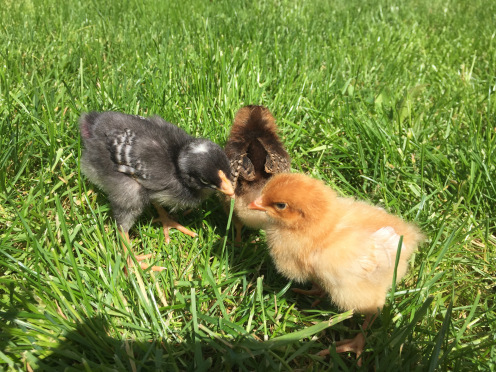
In my last post I introduced our three new chicks and mentioned that it reminded me of a scene from Heirloom, book 3 in the Seed Savers series. In Heirloom, Clare and Dante are living on a farm in Canada and learning about gardening, farming, and such. The setting for the book series is a future where large corporations and the U.S. government have combined and own strict control of the food system. Clare and Dante have escaped to Canada.
Excerpt:
When Marissa had first asked Clare and Dante if they would like to get new chicks and help raise them, they weren’t even sure what she was talking about.
“You know, chicks,” she said. “Baby chickens?”
“You mean we can get some of our own?”
“Yes, Clare, that’s what I’m asking; would you like to? We haven’t gotten any in a few years, but I thought you kids might enjoy it. You would be responsible for taking care of them, and then when they are laying, find customers for the eggs. We already have plenty for John and me and the kids. The money would be yours to keep, of course.”
“Oh, yes!” Clare answered. “It’s more than I ever dreamed of.”
Dante, meanwhile, had started hopping in a circle, doing some kind of happy dance he had recently latched on to.
“How many?” he asked when he finished dancing.
“Oh, I think six would be fine,” Marissa said.
They had intended to get six, but like many things in life, you go about one thing and end up with another.
Before the trip to the nearest farm supply store, Clare had checked out every library book on raising chickens and spent time on the Monitor, as well. She kept Dante up-to-date with her research, and they decided to get six of the same variety, although Dante’s inclination was to get as many different kinds as possible. Clare convinced him, however, that the chickens might get along better if they were the same breed, and together they agreed on Rhode Island Red.
“They’re supposed to be great layers, friendly, and do well in colder weather,” Clare held the book out to Dante, “and look at how pretty they are.”
“What color are the eggs?” he asked.
“Brown.”
“Okay,” he said. “Sounds good.”
Now, however, seven, not six, little peepers hopped around in a large box in the garage: five Rhode Island Reds, one Barred Rock, and one Golden Sex Link. The chicks, of course, looked nothing like the grown chickens Clare and Dante had previewed in the books and Monitor; they were tiny and fuzzy, almost round, and weighed hardly anything. Clare and Dante played with them nonstop until Marissa called them in for supper.
“Now, tell me how you ended up with seven chicks and different breeds,” Marissa asked as they ate the evening meal.
John smiled as he chewed his food. He had taken the kids into town to pick up the chicks.
“Battlestar—”
“—Star—”
“—was just too cute,” Dante said. “He—”
“—she—”
“—was all black with this little white star on its forehead.”
“She really was so adorable,” Clare added. “And so friendly. It was like her little peeps were saying, ‘Choose me, choose me!’”
“And the Sex Link?”
Clare felt embarrassed that a chicken was called Sex Link. It didn’t help that Dante thought it was funny.
“I’m naming her Sexy,” he said.
“No, you aren’t, Dante. She was a mistake,” Clare said to Marissa.
“Oh?”
“What I mean is, we got her by accident because she was in with the Rhode Island Reds. She was a little lighter in color, so we thought maybe she was a Golden Sex Link, but then we decided to keep her at the checkout. And we’re not naming her Sexy,” she said with a tight jaw, glaring at Dante.
Marissa and John smiled at each other as the siblings continued bickering about names throughout the meal.
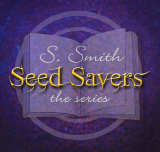 S. Smith is the author of the awesome and award-winning middle grade/YA series,
Seed
Savers.
Visit her
Facebook
and
Pinterest
pages. Follow her on
Twitter
.
Sign up for the newsletter!
S. Smith is the author of the awesome and award-winning middle grade/YA series,
Seed
Savers.
Visit her
Facebook
and
Pinterest
pages. Follow her on
Twitter
.
Sign up for the newsletter!

April 20, 2016
New Chicks In Town
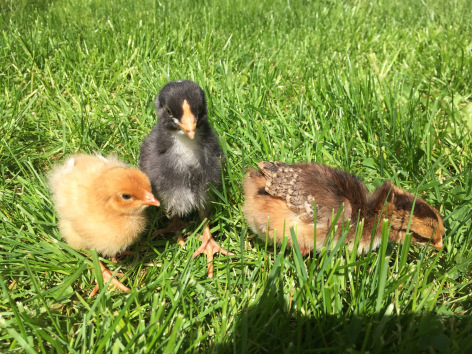
My husband and I recently brought home some baby chicks. This is our second time. The last time was when our kids were still at home. The chicks and the kids grew up. I miss them both. Although there’s not much you can do when your kids move out, I did decide I’d had enough of the quiet yard, the empty coop. So although it will be a few months before they are “the ladies,” we are enjoying having babies again. Let me introduce you:
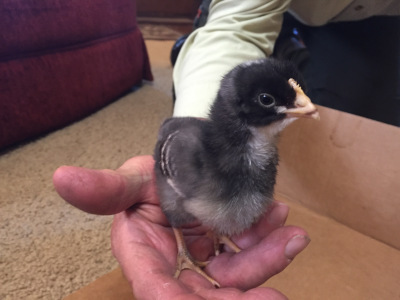
This is Dixie. She’s a Barred Plymouth Rock. Our last Barred Rock was Clover and she was a sweetie.
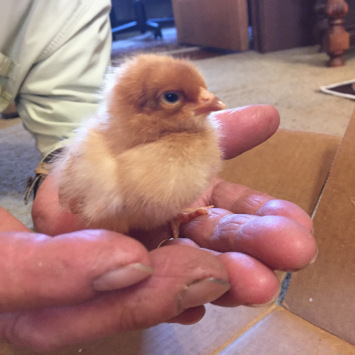
This is Ginger (Gingersnap). She is a Novogen, also known as a Red Sex Link. She has a gentle, calm disposition.
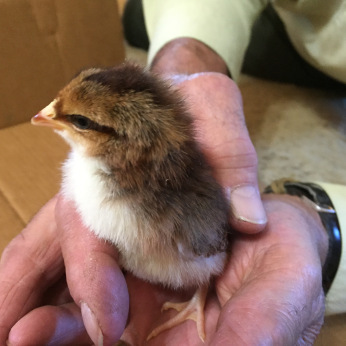
This is Lolli (Lollipop). Her alternate name is FancyPants. We will see which one she grows into better. She is very active, always on the move! She is a Speckled Sussex.
Looking at the photos of the chicks reminded me of the scene in Heirloom when Clare and Dante get to choose and name several chicks for the first time. I’ll post the excerpt next time.
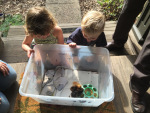
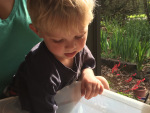
Do you have chicks or chickens? What have been some of your favorite breeds to raise? Leave a comment![image error]
S. Smith is the author of the awesome and award-winning middle grade/YA series, Seed Savers. Visit her Facebook and Pinterest pages. Follow her on Twitter . Sign up for the newsletter!

April 11, 2016
Every School & Library Should Own the Seed Savers Series
The what? If you aren’t a regular follower of this blog, chances are you haven’t heard of the Seed Savers series by S. Smith. The series straddles the line between middle grade and young adult. The first book is younger and as the series continues–as one reviewer stated of the fourth book–Keeper, “this book seems to move out of Middle Grade territory into full-blown dystopia.”
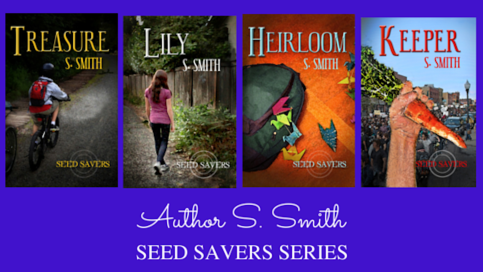
“She was having a hard time understanding what she read. How did seasons relate to food? What did ‘ripen’ mean? What did it mean to ‘grow’ food?”
Like much of Paolo Bacigalupi’s work, Seed Savers is a book series about a future we’re creating today. In Seed Savers, corporations and government have merged and taken control of the food supply. Real food, as we know it today, is completely gone from store shelves, gardening and seed saving against the law.
The future will thank you.
The series stars children because children are the future. The first book in the series is Treasure. Treasure has been lexiled at 660. The ISBN is 9781943345038 and it’s available through Ingram in paperback.
“Smith’s Seed Savers books are great reads for young people on many levels. The action is packed with secret acts of civil disobedience, escape from evil GRIM thugs and independent cross-country treks. Plus, teens will both recognize and learn about issues surrounding food sources. Seed Saver books have something for everyone: diverse characters, themes of empowerment, revolution, and even a little romance.”
Currently, all of the Seed Savers ebooks are on sale at Amazon at the same time. This only happens once or twice a year. Give them a try. Order them for your library. The future will thank you.
Read reviews about the books on their Amazon pages and download your copy today.
“I can’t wait for the movie!”
S. Smith is the author of the awesome and award-winning middle grade/YA series, Seed Savers. Visit her Facebook and Pinterest pages. Follow her on Twitter . Sign up for the newsletter!


